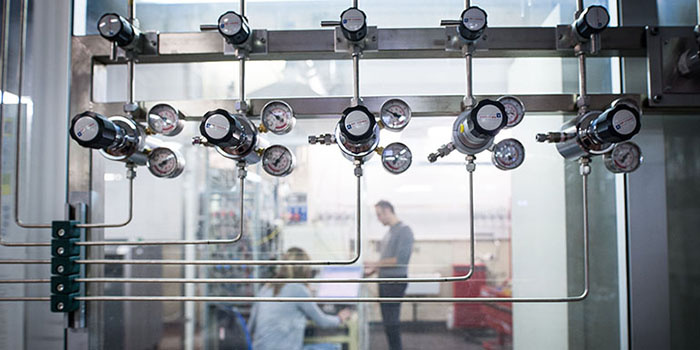Use of Compressed Gases and Cylinders

Gases stored in cylinders or that flow through pipelines from cylinder enclosures to supply laboratory equipment, at a pressure that is greater than atmospheric pressure, can be classified as three types: inert, toxic and flammable or combustible.
An inert gas (such as nitrogen, argon and helium, etc.) is a gas that is not toxic, which does not support human breathing and which reacts little or not at all with other substances. If an inert gas, contained in a cylinder, was accidentally leaked into the atmosphere, it would dilute the oxygen concentration in the air. Under ordinary conditions, air is composed, by volume, of approximately 21% oxygen. The Occupational Safety and Health Administration (OSHA) defines safe oxygen concentration levels at the workplace as being between 19.5% and 23%. Therefore, the risk that must be assessed and prevented is that of over- or under-oxygenation. Where, in the laboratory in question, in the presence of inert gases, there is the risk of asphyxiation due to oxygen depletion, oxygen detection equipment must be installed in the vicinity of any gas leakage points.
When toxicgases are inhaled they can be fatal or lead to acute or chronic injuries. The maximum concentration of each substance to which an individual can be exposed for a given period without injuring their health is defined by law. Where, in the presence of such gases, there is the risk of harmful effects on health, detection equipment must be installed in the vicinity of any gas leakage points to measure the concentration of the gas in question.
Flammable or combustible gases are gases that, when mixed with air (i.e., with the oxygen component) in certain proportions, could cause an explosive atmosphere. Each flammable gas has a lower explosive limit (LEL), which is the concentration of the gas in air, below which the gas atmosphere is not explosive. In laboratories where an explosive atmosphere could be created, sensors should be installed in the vicinity of any points where the gas could accidentally leak in order to block the gas flow from the cylinder should the sensors detect a concentration of the gas close to its LEL.
Caution: Cylinders containing toxic and explosive gases (acetylene) must not be stored in laboratories. Cylinders containing flammable and combustible gases (oxygen) may be stored in laboratories, but only in specific cabinets.
For more informations, refer to the Guide to Gas Management (ITA) and the Guide to Gas Cylinders Management (ITA).
